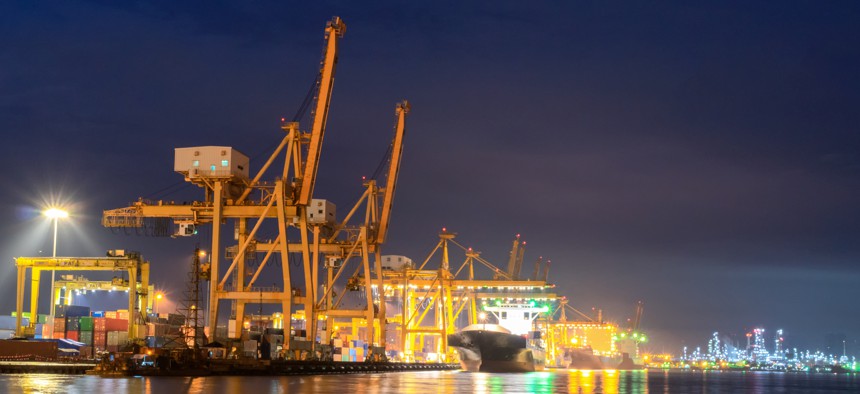Chips and talent remain key indicators of today's supply chain health

Gettyimages.com/ Cravetiger
General Dynamics and Raytheon give their investors the lay of the land as both companies see it.
Defense companies continue to face shortages of both computer chips and talent, all of which factor into supply chain challenges. Executives from General Dynamics and Raytheon have described those challenges across the government market in their third quarter earnings calls with investors.
General Dynamics
No sector of the economy can claim to be completely insulated from the global shortage of computer chips and other microelectronics, whether it be how companies manage their own technology environments or deliver products to customers.
In the context of General Dynamics, its mission systems business that makes IT hardware and other specialized electronics is where the chip shortage continues to be the most pronounced.
"While they had a lot of the more pedestrian supply chain challenges, specialty chips continue to dog them and the additional delays that they experienced in the quarter were very, very hard for them," GD CEO Phebe Novakovic said during that company's call Wednesday.
"They produce several high-value complex products that have experienced delays before, but again, even beyond some of the chip problems, some of the specialty products going into that production those production lines were also impacted."
Mission Systems has these two other headwinds Novakovic cited: shortages of contracting officers responsible for decisions regarding funding and program execution, plus the Defense Department's shift of focus to the defense of Ukraine.
General Dynamics' technologies segment comprises of Mission Systems and GDIT -- the defense company's IT services and integration business unit. Novakovic characterized the segment as a "tale of two cities."
Year-to-date wins at GDIT have exceeded last year's awards in dollar terms, Novakovic said. GDIT expects to see revenue growth this year as it did last year, she added.
If only the headwinds could escape Mission Systems .
"The demand for their high-value products is out there, it's just the inability to deliver because of the supply chain is constraining some of the orders," Novakovic said. "They're just waiting to be executed once we get through all of this, and we will, we will get through it."
Fourth quarter technologies revenue of $3.07 billion was 1% lower compared to the prior year period. Novakovic said that decline is "fairly evenly split in dollar terms" between Mission Systems and GDIT.
GD now expects the technologies segment to fall short of its prior estimates of $12.9 billion in revenue.
Overall corporate sales of $10 billion showed a 4.3% year-over-year increase. GD sees the full year's revenue number as being in-line with its prior outlook of nearly $39.4 billion, or nearly 2% growth.
Raytheon Technologies
The now Arlington, Virginia-headquartered company put some numbers to how it is managing the supply chain and labor situation during that company's call Tuesday.
CEO Greg Hayes said that of Raytheon's nearly 13,000 suppliers, "about 400 of them are a problem for us." Hayes also said Raytheon has deployed teams to work with them on all aspects ranging from materials to labor.
Hayes describes the company's market headwinds in the clip below from CNBC's Squawk on the Street program.
Raytheon also needs to hire "about 10,000 more people" in order to fulfill its order book, Hayes said. Employee hires have totaled 27,000 this year at a rate of nearly 3,000 per month.
Some stabilization did happen in the quarter on the supply chain and talent fronts, but those pressures remain on Raytheon and the industry at-large. Hayes told analysts that a meeting was scheduled for Wednesday (today) with Defense Department leaders to discuss ways to keep supply chains moving.
At least from Raytheon's perspective, the flow of computer chips and other microelectronics that go into larger systems appears to be showing signs of improvement amid the heightened focus on the problems there.
"We have worked with like the chip manufacturers, the (original equipment manufacturers) to get some assured supply, and that seems to be working," Hayes said. "The offset of that of course, is it's a lot of inventory sitting here."
Inflation presents an entirely different picture for Raytheon that is not entirely clear as to which direction that trend is going, other than the fact that it will be around in 2023.
Hayes said the most significant impact to Raytheon from inflation is on employee compensation, for which the company spends roughly $20 billion per year on. Raytheon's targeted annual increase rate there has been 3%-to-3.5% for the last 10 years.
"We're obviously seeing more pressure on compensation given what's going on in the marketplace today, but the fact is, this is not new," Hayes said. "We are always looking for productivity improvements, productivity improvements in the factories, productivity in the back-office functions and everything that we do.
Fourth quarter revenue of $17 billion was 6% higher on an organic basis compared to the same period last year when factoring in divestitures, including the sale of the training and services business to the former Vertex Aerospace.
Raytheon now sees this year's sales in the range of $67 billion-to-$67.3 billion, down from the prior forecast of $67.75 billion-to-$68.75 billion. The new outlook suggests organic growth of between 5% and 6% compared to the previous range of 6%-to-8%.
NEXT STORY: HHS works to expand its industrial base


